13 Tips For The Best Homemade Tomato Soup

When it comes to comfort food, few dishes evoke the same feelings of warmth and satisfaction as a steaming bowl of tomato soup. It's a timeless standby, a culinary hug in a bowl that has graced kitchen tables for generations. Whether paired with a gooey grilled cheese sandwich or savored on its own, this red-hued soup holds a special place in our hearts.
But what if we told you that there's more to tomato soup than meets the eye? That beneath its unassuming surface lies a world of flavor waiting to be unlocked. For those who crave the exquisite, yearn for the homemade, and aspire to make the best tomato soup possible, you've come to the right place. In this article, we'll delve into the art of perfecting tomato soup, offering you 13 tips for making the best homemade tomato soup possible. From the choice of tomatoes and sweeteners to the wonders of roasting and the magic of herbs, we'll guide you step by step on a flavorful journey that will leave an impression on your taste buds long after the last spoonful.
Read more: 20 Popular Canned Soups, Ranked Worst To Best
Using High-Quality, Fresh Tomatoes Is A Must
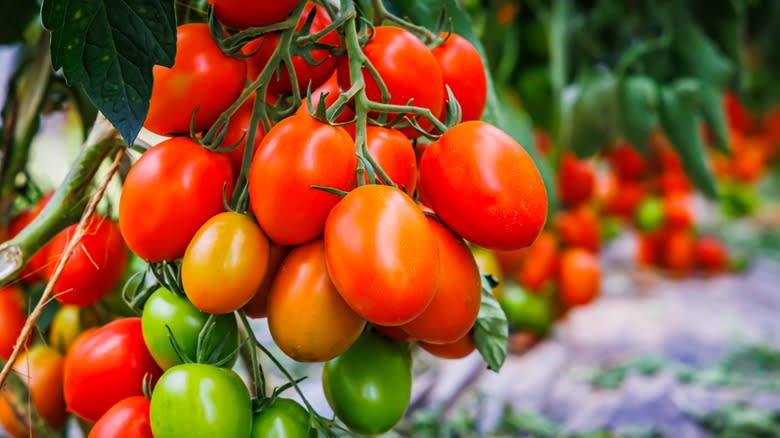
When it comes to crafting the perfect homemade tomato soup, the foundation of flavor lies in your choice of tomatoes. While it may be tempting (and convenient) to grab the canned variety, opting for high-quality, fresh tomatoes makes a world of difference. Fresh tomatoes bring a burst of complexity that canned counterparts simply can't replicate. Plus, fresh tomatoes allow you to adjust the seasoning and acidity to your liking, giving you full control over the final product.
Now that you're on board with using fresh tomatoes, make sure you're using the right variety. Our favorites are Roma and San Marzano. We appreciate Roma tomatoes for their meaty flesh, relative lack of seeds, and low moisture content. They're also high in sugar and acidity, giving them a robust flavor profile. San Marzano tomatoes are native to the Campania region near Naples, Italy. That's reason enough to reach for this elongated variety, but it's their dense flesh, small seeds, and sweet flavor that make them perfect for tomato soup.
Opt For Canned Tomatoes Out Of Season
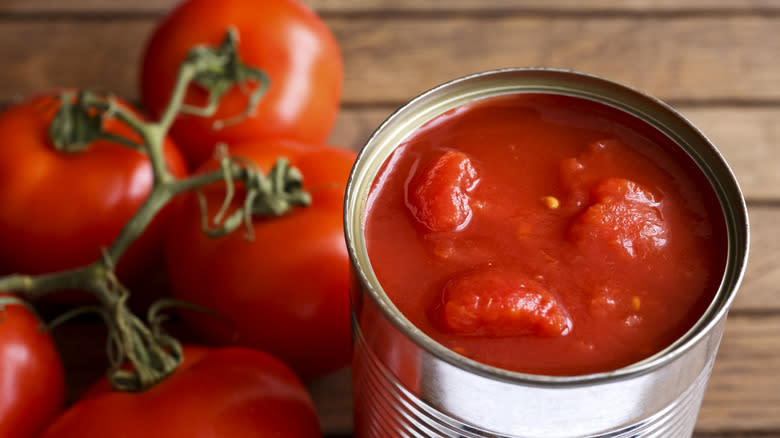
While fresh, ripe tomatoes are usually the key to exceptional tomato soup, the sad fact is that these vibrant orbs aren't available year-round. That doesn't mean you have to give up your quest for a comforting bowl of soup in the dead of winter. It just means that you have to adjust your strategy. Enter canned tomatoes — the ultimate alternative when fresh tomatoes are out of reach.
If you're feeling icky just thinking about the sloppy mess usually found in a can of tomatoes, we get it. The experience of opening a can pales in comparison to selecting bright, flawless tomatoes from your local farmers market. However, it may be helpful to know that canned tomatoes are frequently harvested and preserved at their peak, typically during the height of tomato season. Translation? They may not look like much, but they're bursting with flavor that rivals the bland, out-of-season tomatoes you'll find in winter. While most types of canned tomatoes will do the trick, we recommend using whole peeled tomatoes for the best results. Another advantage of using canned tomatoes is that they offer consistent flavor and texture. That means your tomato soup maintains its deliciousness, regardless of when you make it.
Cook In A Non-Reactive Pot
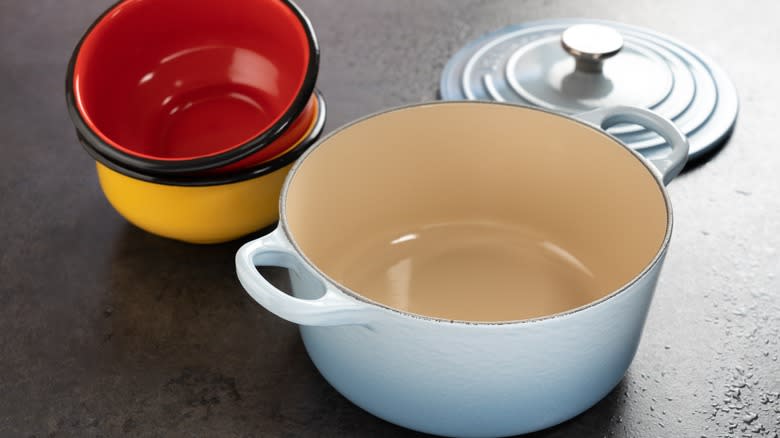
While you might not give a second thought to cookware when embarking on your culinary adventures, making tomato soup demands a closer look at your pots and pans. That's because this seemingly mundane choice can seriously impact the flavor and quality of your soup. The reason lies in tomato soup's acidity. The same delightful tang that you enjoy slurping will create a reaction with pots made out of aluminum, cast iron, and copper, giving an unwanted metallic tinge to your soup.
To make the best homemade tomato soup possible, opt for non-reactive pots and pans. These are made with materials that won't interact with acidic ingredients, safeguarding the taste and appearance of your dish. Top choices include Dutch ovens, stainless steel, glass, and enamel. Their surfaces remain steadfast in the face of acidity, allowing the soup's flavors to shine through without any unwelcome metallic undertones. Nonstick cookware can also work, provided it's scratch-free. Scratched nonstick pots can release plastic particles and expose the underlying metal, potentially leading to unwanted reactions with the tomatoes.
Choose Your Onions Wisely
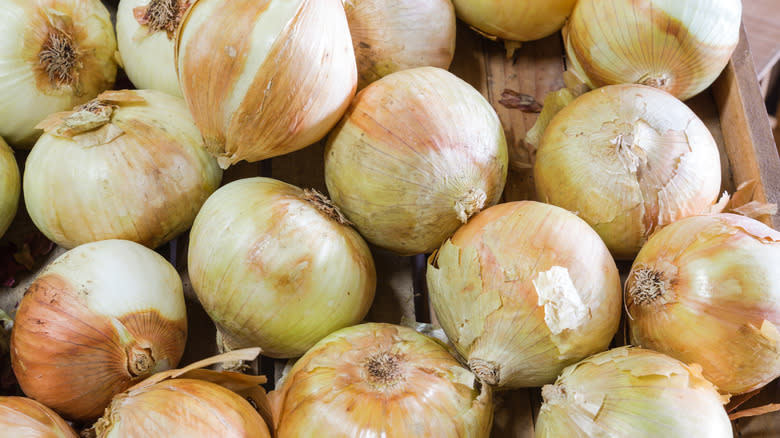
In the delicate dance of flavors that is tomato soup, onions play a pivotal role. In many cases, they can mean the difference between a pot of soup that sings with sweet, balanced notes and one that leans toward the tart and acidic. Set the right tone by selecting the right onion variety to complement the tomatoes in your go-to recipe.
Sweet varieties like Vidalia, Maui, and Texas Sweet are the pinnacle of perfection when it comes to alliums. The gentle, mellow notes of these onions offset the tanginess of the tomatoes, creating a well-balanced flavor profile for a soup that's not just palatable but downright delightful. As a bonus, sweet varieties are also lower in sulfur than other onion varieties, meaning you won't tear up as you chop them. If you can't get your hands on these sweet onions, don't fret. With their rich sweetness, yellow onions can step in admirably. However, if you've got an urgent tomato soup craving that needs immediate attention, white onions, red onions, and even shallots can step in to fill the void.
Don't Be Afraid Of Garlic
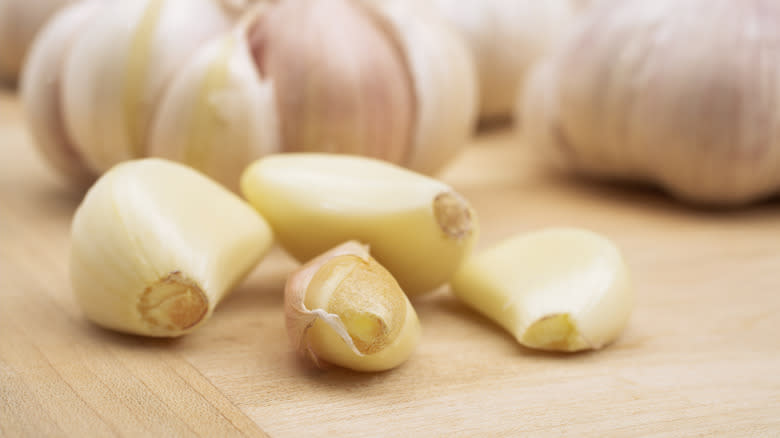
When it comes to crafting the perfect tomato soup, there's one ingredient that not everyone thinks to add, but they absolutely should: garlic. Prepared correctly and used with care, this humble bulb holds the power to elevate your tomato soup to a whole new level of flavor complexity. In addition to an irresistible layer of sweetness, garlic's subtle yet distinct taste helps counteract the natural acidity of tomatoes, resulting in a harmonious blend that tantalizes the taste buds.
For those who fear its overpowering pungency, rest assured that when handled with care, garlic becomes a gentle aromatic. One trick when cooking with garlic is to use whole cloves, rather than dicing or mincing them. That may sound counterintuitive, but it all comes down to food science. Garlic's heady aroma and taste come from alliinase, a sulfuric enzyme. This compound gets released the more you chop and crush garlic, but not so much when the cloves are left intact. Therefore, if a subtle aroma is what you're after, slip a couple of whole cloves into the soup. Just remember to remove them before serving!
Roasting Works Wonders

When time is on your side and you're in pursuit of tomato-soup excellence, consider the transformative power of roasting. It's a patient approach that pays off in the form of unparalleled flavor. Take advantage of this magnificent technique by preheating your oven to 400 degrees Fahrenheit. Next, toss tomatoes, onions, and garlic (keep the peel on or it will burn in the oven) in olive oil. Season this vibrant trio with salt and pepper to taste before laying them out in a single layer on a baking sheet. Finally, roast for 40 minutes and let the magic unfold.
While simple, roasting is a process that coaxes out the natural sweetness of tomatoes, caramelizes the onions, and imbues the garlic with a subtle, smoky allure. Once the ingredients emerge from the oven, allow them to cool (and peel the garlic), then blend with a few basil leaves and a bit of cream like we do in our roasted tomato soup recipe. Your taste buds won't know what hit them!
A Sweetener Removes Acidity

If you're serious about making the best homemade tomato soup possible, then you'll need to confront the issue of acidity at one point or another. Although butter and aromatics contribute their fair share of sweetness, there comes a point where the tanginess of the tomatoes remains a bit too assertive. When that happens, it's time to turn to sweeteners for a helping hand.
The go-to sweetener for many is a simple tablespoon of white sugar. Its fine, granulated form effortlessly dissolves into the simmering soup, coaxing the tomatoes toward a mellower, sweeter disposition. However, the beauty of tomato soup lies in its adaptability, and there are plenty of alternative sweeteners that not only whip tomatoes into shape but also lend their unique nuances to the overall flavor profile. For instance, the floral undertones of honey introduce a subtle complexity, while maple syrup brings rich caramel and toffee notes. For those seeking a healthier option, agave nectar offers a gentle sweetness with a low glycemic index.
Choose Broth Over Water
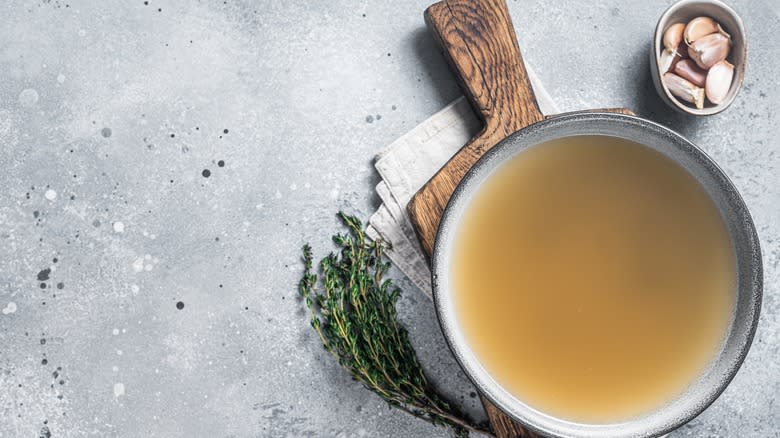
For a tomato soup that exudes richness and satisfaction, your choice of liquid base plays a crucial role. While many recipes rely on water, selecting a flavorful broth is a surefire way to elevate tomato soup to new heights. Both vegetable and chicken broth are popular choices. Vegetable broth introduces a medley of earthy notes, while chicken broth offers a savory, umami-laden dimension to your tomato soup.
Not to slam these beloved broths, but if you're aiming for the utmost in tomato-soup satisfaction, consider experimenting with bone broth. More than a trendy ingredient, bone broth imparts a luxurious quality to your soup that's hard to match. That's thanks in large part to its collagen-rich composition. In case you're unfamiliar, collagen is a structural protein found in the skin, bones, and connective tissues. When used in cooking, bone broth gives dishes a thick, silky texture that's oh-so-satisfying. Even better, bone broth contains protein and amino acids, making it easy to get your daily macros without even trying.
Experiment With Herbs
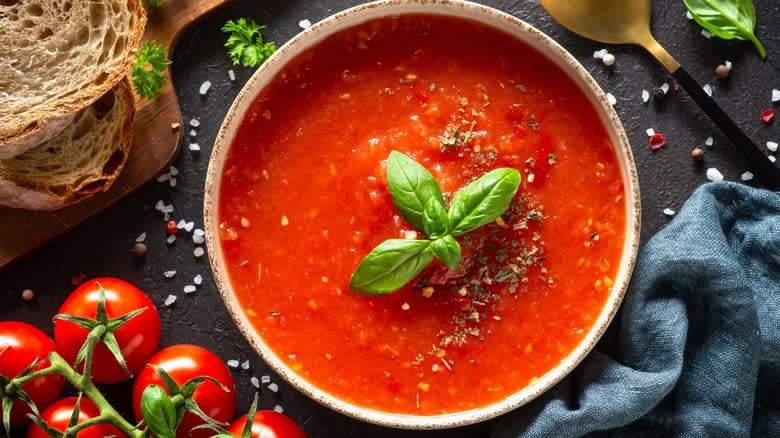
The best homemade tomato soups leverage the power of fresh ingredients, in particular tomatoes and herbs. Although basil is a timeless favorite — providing a pop of color and a sweet, slightly spicy flavor — it would be a shame to limit yourself to a single choice. Indeed, familiar herbs like rosemary, thyme, chives, and parsley do wonders to bring this simple recipe to life.
Rosemary introduces warm, earthy notes that provide depth to this often one-note soup. Thyme, a cousin of mint, adds a gentle herbaceous character, offering a unique complement to tangy tomatoes. Chives bring a mild oniony kick that plays off of the other alliums, while parsley is the ideal finishing touch when your soup needs a dose of freshness. And if you're feeling particularly adventurous, take a cue from renowned celebrity chef Ina Garten, who adds saffron to her recipe. Saffron, with its distinctive floral essence, lends an exotic touch that's sure to turn your tomato soup into a gourmet delight.
Add Something Creamy

Incorporating creamy ingredients not only gives your homemade tomato soup a luxurious texture, but also helps balance the vibrant acidity of the tomatoes. Classic choices like butter and cream are tried and true, lending silky smoothness to this cherished soup. If butter is your creamy addition of choice, then feel free to use it liberally when sautéing your onions and garlic. This initial step allows the butter to meld with the aromatic base, infusing the soup with a velvety undertone right from the beginning. Cream is often introduced just before serving to ensure it doesn't curdle.
Tomato soup can be made creamy with vegan ingredients, too. Coconut milk, with its luscious consistency and gentle tropical notes, offers a rich creaminess that pairs exceptionally well with the tomato's natural sweetness. We use full-fat unsweetened coconut milk in our vegan roasted tomato soup recipe, but feel free to use a reduced-fat option to keep your soup on the lighter side. Almond milk and cashew cream are two more dairy-free options we love, with both providing creamy, nutty undertones that pair beautifully with tomatoes. You can even try adding tahini (aka the sesame-seed-based spread used to make hummus) for a subtly sweet layer that won't interfere with the other ingredients.
Tomato Paste Is Your Ally
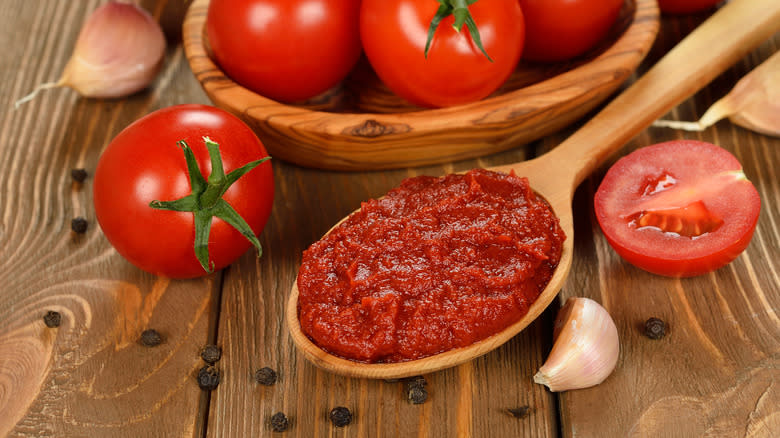
While fresh tomatoes often steal the spotlight, let's not underestimate the pivotal role of tomato paste in crafting an exceptional tomato soup. Just a couple of tablespoons of this concentrated essence elevate the tomato flavor, making the difference between a decent bowl of tomato soup and a lick-the-bowl one.
To harness the full potential of tomato paste, incorporate it into your cooking process strategically. As soon as the onions and garlic have softened and started releasing their aromas, it's time to add this essential ingredient. Allow the ingredients to mingle in the pan, making sure to stir frequently. Watch for the tomato paste to darken. This change indicates that it has lost its bitter, metallic flavor. Once that happens, take a few seconds to scrape the bottom of the pot with a wooden spoon. This step frees all of those tasty caramelized bits, allowing them to integrate into the fresh tomatoes and broth you'll add later on.
Remember The Croutons

We've got a confession to make: As much as we adore a steaming bowl of tomato soup, we're mostly here for the croutons. Besides being ridiculously delicious, these crispy, golden nuggets add a satisfying crunch that provides a welcome contrast to the sometimes monotonous flavor and texture of tomato soup. Traditionalists might opt for classic, oven-toasted cubes of bread, seasoned with a touch of olive oil and a pinch of salt. This simple recipe pairs perfectly with the comforting, familiar taste of tomato soup, but it can feel a bit expected.
For a more adventurous crouton experience, consider experimenting with different types of bread. As an example, sourdough croutons lend a tangy twist, while the whole wheat variety adds nutty depth. If you really want to go all out, then look no further than cheese croutons. They bring together cheddar and Parmesan, elevating basic croutons to new heights. (Don't worry, your grilled cheese won't be too jealous.)
Finish With A Drizzle Before Serving
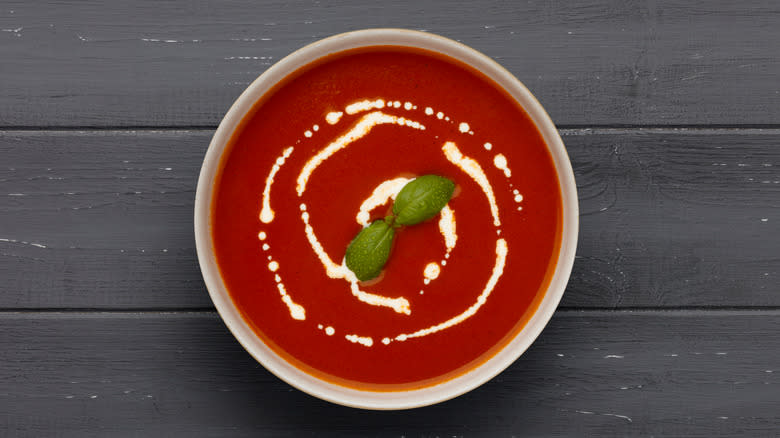
Before plating, take the time to introduce a drizzle to your dish. This often-overlooked finishing touch gives your homemade tomato soup an air of sophistication sure to rival your favorite restaurant's recipe. But these final flourishes aren't just aesthetically pleasing, they're yet another opportunity to infuse your soup with an extra layer of flavor.
When it comes to drizzles and dollops, the options are diverse, and the choice is yours. If velvety creaminess is what you're after, consider stirring in crème fraîche, sour cream, or Greek yogurt. Their silky textures meld seamlessly with the rich tomato base, adding a luscious dimension to this already cozy dish. For a savory, herbal twist, deposit a dollop of pesto on the soup's surface. Bursting with basil, garlic, cheese, and pine nuts, pesto hits all of the right notes. And for those craving rich, complex sweetness, a quick pour of balsamic vinegar will do the trick.
Read the original article on Tasting Table.

